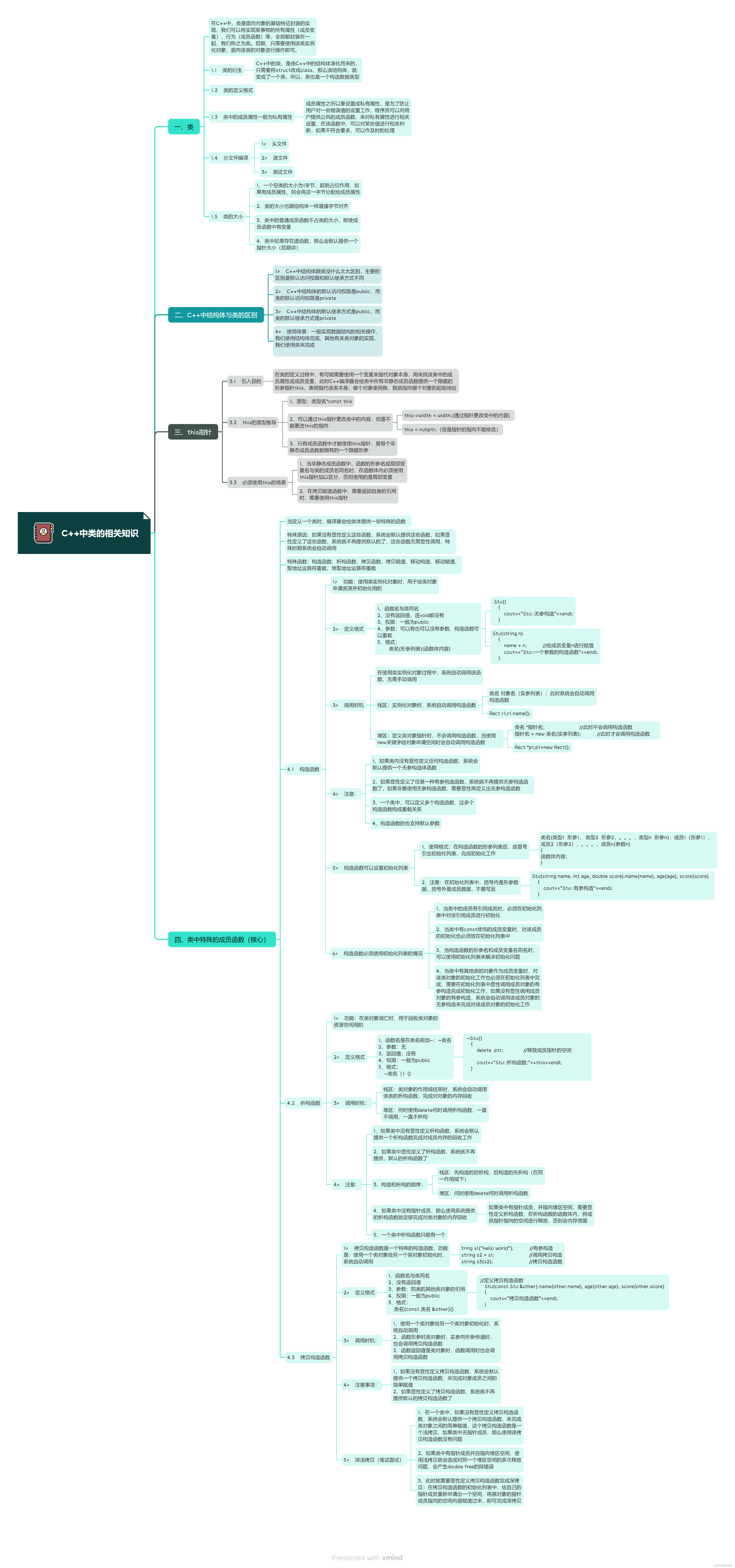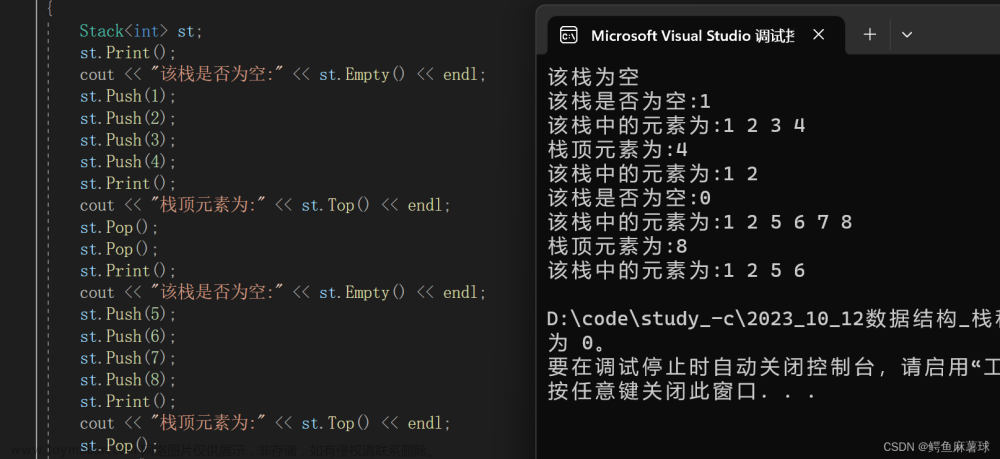
书读一边家里见
书读三遍大专见
书读百遍清北见
书读零遍感谢大哥的穿云箭🚀
一、栈
1、栈的概念及结构
2、栈的实现
二、队列
1、队列的概念及结构
2、队列的实现
三、栈和队列对比
四、完结撒❀
–❀–❀–❀–❀–❀–❀–❀–❀–❀–❀–❀–❀–❀–❀–❀–❀–❀–❀–❀–❀–❀–❀–❀–❀–❀–❀–❀–❀–❀–❀–❀–❀–❀–❀–❀–❀–❀–❀–❀–❀–❀–
一、栈
1、栈的概念及结构
概念
栈:一种特殊的线性表,其只允许在固定的一端进行插入和删除元素操作。进行数据插入和删除操作的一端称为栈顶,另一端称为栈底。栈中的数据元素遵守后进先出LIFO(Last In First Out)的原则。
压栈:栈的插入操作叫做进栈/压栈/入栈,入数据在栈顶。
出栈:栈的删除操作叫做出栈。出数据也在栈顶。
要进行比喻的话,可以拿栈和肉串进行比较,因为都是先插进去的后出来。
看下动图方便大家理解:
入栈: 出栈:
出栈: 可以看出来,先入栈的后出,后入栈的先出,并且
可以看出来,先入栈的后出,后入栈的先出,并且
数据的删除和插入都是在栈顶进行。
2、栈的实现
栈的实现一般可以使用数组或者链表实现,相对而言数组的结构实现更优一些。因为数组在尾上插入数据的代价比较小。
静态栈实际中一般不实用,所以我们主要实现下面的支持动态增长的栈。
下面我们分装stack.c,和stack.h两个文件进行实现。
栈实现所包括的函数与顺序表有所不同,大家认真观看学习。
stack.c:
#include "stack.h"
//初始化
void STInit(ST* ps)
{
assert(ps);
ps->a = NULL;
ps->top = ps->capacity = 0;
}
//销毁
void STDestory(ST* ps)
{
assert(ps);
free(ps->a);
ps->a = NULL;
ps->capacity = ps->top = 0;
}
//入栈
void STPush(ST* ps, STDataType x)
{
assert(ps);
//空间不足
if (ps->capacity == ps->top)
{
int newcapacity = ps->capacity == 0 ? 4 : ps->capacity * 2;
STDataType* tmp = (STDataType*)realloc(ps->a, newcapacity*sizeof(STDataType));
if (tmp == NULL)
{
perror("realloc fail:");
return;
}
ps->a = tmp;
ps->capacity = newcapacity;
}
ps->a[ps->top] = x;
ps->top++;
}
//返回最后一位
STDataType STTop(ST* ps)
{
assert(ps);
assert(!STEmpty(ps));
return ps->a[ps->top-1];
}
//删除最后一位
void STPop(ST* ps)
{
assert(ps);
assert(!STEmpty(ps));
ps->top--;
}
//返回栈总个数
int STSize(ST* ps)
{
assert(ps);
return ps->top;
}
//判断栈是否为空
bool STEmpty(ST* ps)
{
assert(ps);
return ps->top == 0;
}
stack.h:
#define _CRT_SECURE_NO_WARNINGS 1
#include <stdio.h>
#include <stdlib.h>
#include <stdbool.h>
#include <assert.h>
typedef int STDataType;
typedef struct stack
{
STDataType* a;
int top;
int capacity;
}ST;
//栈初始化
void STInit(ST* ps);
//栈销毁
void STDestory(ST* ps);
//栈顶
//入栈
void STPush(ST* ps, STDataType x);
//出栈
//删除最后一位
void STPop(ST* ps);
//返回最后一位
STDataType STTop(ST* ps);
//返回栈总个数
int STSize(ST* ps);
//判断栈是否为空
bool STEmpty(ST* ps);
bool isValid(char* s);
二、队列
1、队列的概念及结构
队列:只允许在一端进行插入数据操作,在另一端进行删除数据操作的特殊线性表,队列具有先进先出FIFO(First In First Out)
入队列:进行插入操作的一端称为队尾
出队列:进行删除操作的一端称为队头

2、队列的实现
队列也可以数组和链表的结构实现,使用链表的结构实现更优一些,因为如果使用数组的结构,出队列在数组头上出数据,效率会比较低(需要将数组头之后的数据全部进行前移)。
下面我们也是实现动态增长的队列:
Queue.c:
#include "Queue.h"
//初始化
void QueueInit(Queue* pq)
{
assert(pq);
pq->phead = pq->ptail = NULL;
pq->size = 0;
}
//销毁
void QueueDestroy(Queue* pq)
{
assert(pq);
while (pq->phead)
{
QNode* cur = pq->phead->next;
free(pq->phead);
pq->phead = cur;
}
pq->phead = pq->ptail = NULL;
pq->size = 0;
}
//入队列
void QueuePush(Queue* pq,QDataType x)
{
assert(pq);
QNode* newnode = (QNode*)malloc(sizeof(QNode));
if (newnode == NULL)
{
perror("malloc fail");
return;
}
newnode->val = x;
newnode->next = NULL;
//当队列为空
if (pq->ptail == NULL)
{
pq->phead = pq->ptail = newnode;
}
else
{
pq->ptail->next = newnode;
pq->ptail = newnode;
}
pq->size++;
}
//出队列(但不返回值)
void QueuePop(Queue* pq)
{
assert(pq);
assert(pq->phead);
if (pq->phead == pq->ptail)
{
free(pq->phead);
pq->phead = pq->ptail = NULL;
pq->size--;
}
else
{
QNode* cur = pq->phead->next;
free(pq->phead);
pq->phead = cur;
pq->size--;
}
}
//返回头节点的值
QDataType QueueFront(Queue* pq)
{
assert(pq);
assert(pq->phead);
return pq->phead->val;
}
//返回尾节点的值
QDataType QueueBack(Queue* pq)
{
assert(pq);
assert(pq->phead);
return pq->ptail->val;
}
//判断队列是否为空
bool QueueEmpty(Queue* pq)
{
assert(pq);
return pq->size == NULL;
}
//返回队列中的个数
int QueueSize(Queue* pq)
{
assert(pq);
return pq->size;
}
Queue.h:
#define _CRT_SECURE_NO_WARNINGS 1
#include <stdio.h>
#include <stdlib.h>
#include <stdbool.h>
#include <assert.h>
typedef int QDataType;
typedef struct QueueNode
{
QDataType val;
struct QueueNode* next;
}QNode;
typedef struct Queue
{
QNode* phead;
QNode* ptail;
int size;
}Queue;
//初始化
void QueueInit(Queue* pq);
//销毁
void QueueDestroy(Queue* pq);
//入队列
void QueuePush(Queue* pq, QDataType x);
//出队列(但不返回值)
void QueuePop(Queue* pq);
//返回头节点的值
QDataType QueueFront(Queue* pq);
//返回尾节点的值
QDataType QueueBack(Queue* pq);
//判断队列是否为空
bool QueueEmpty(Queue* pq);
//返回队列中的个数
int QueueSize(Queue* pq);
三、栈和队列对比
1.栈在栈顶进行数据的插入和删除,而队列在队尾进行插入,在对头进行删除。
2.栈使用数组更优,而队列使用链表更优。
3.栈先进后出,队列先进先出。文章来源:https://www.toymoban.com/news/detail-845645.html
四、完结撒❀
如果以上内容对你有帮助不妨点赞支持一下,以后还会分享更多编程知识,我们一起进步。
最后我想讲的是,据说点赞的都能找到漂亮女朋友 文章来源地址https://www.toymoban.com/news/detail-845645.html
文章来源地址https://www.toymoban.com/news/detail-845645.html
到了这里,关于数据结构进阶篇 之 【栈和队列】的实现讲解(附完整实现代码)的文章就介绍完了。如果您还想了解更多内容,请在右上角搜索TOY模板网以前的文章或继续浏览下面的相关文章,希望大家以后多多支持TOY模板网!












